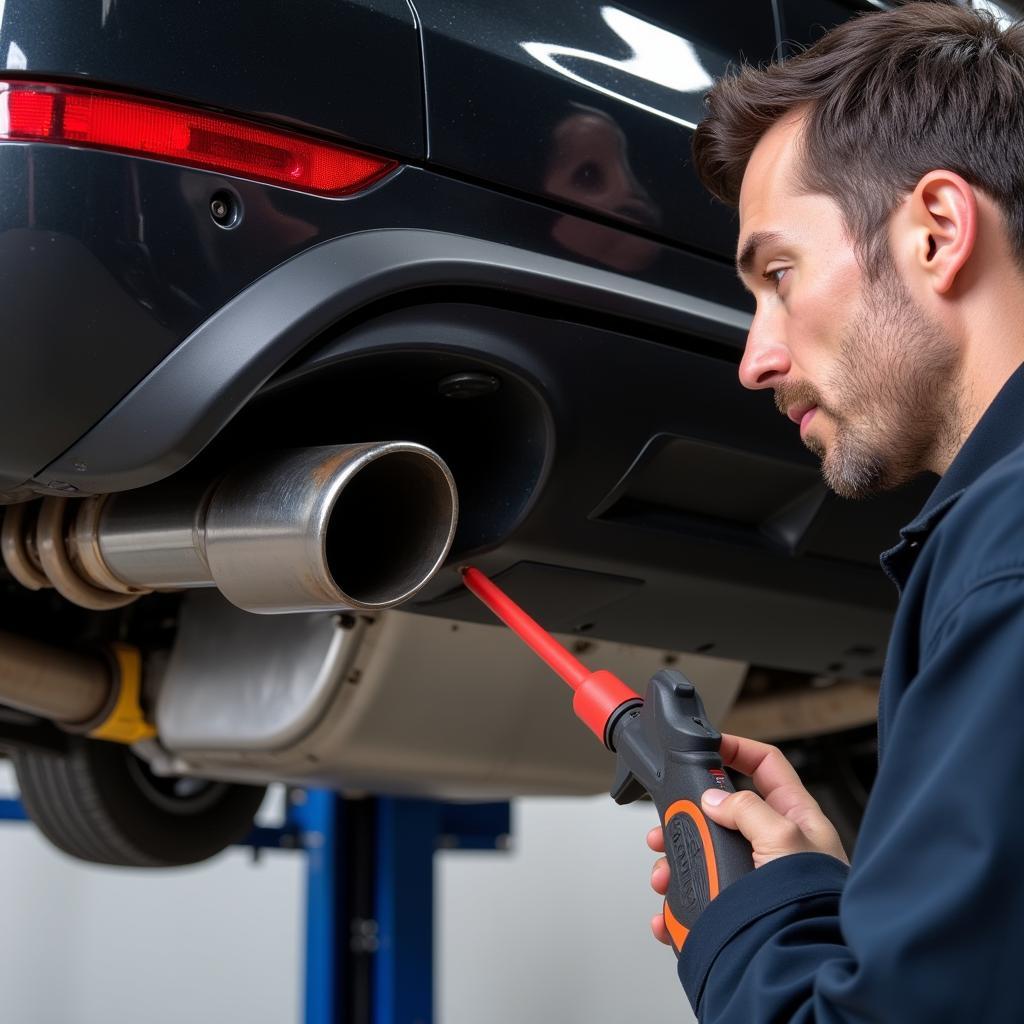Your cart is currently empty!

Porsche Cayenne Fault Code 01314: Oxygen Sensor Circuit Malfunction (Bank 1, Sensor 2)
The dreaded “Check Engine” light can strike fear into the heart of any Porsche Cayenne owner. When accompanied by the fault code 01314, it signals a potential problem with your vehicle’s oxygen sensor circuit, specifically Bank 1, Sensor 2. This guide will walk you through understanding this code, its potential causes, and how to troubleshoot the issue, helping you get back on the road with confidence.
Understanding Oxygen Sensors and Their Importance
Oxygen sensors, also known as O2 sensors, play a critical role in maintaining your Porsche Cayenne’s performance and fuel efficiency. These small devices, usually located in the exhaust manifold or exhaust pipe, monitor the oxygen content in your vehicle’s exhaust gases. This information is relayed to the engine control unit (ECU), which adjusts the air-fuel mixture accordingly, ensuring optimal combustion and reduced emissions.
 Porsche Cayenne oxygen sensor location
Porsche Cayenne oxygen sensor location
The “Bank 1, Sensor 2” designation in the fault code 01314 refers to a specific sensor in your Cayenne’s exhaust system. “Bank 1” indicates the side of the engine containing cylinder #1, while “Sensor 2” refers to the downstream oxygen sensor, positioned after the catalytic converter. This sensor monitors the efficiency of the catalytic converter in reducing harmful emissions.
What Causes Porsche Cayenne Fault Code 01314?
A fault code 01314 in your Porsche Cayenne indicates a malfunctioning circuit for the downstream oxygen sensor on Bank 1. This can be caused by several factors, including:
- Faulty Oxygen Sensor: The most common culprit is a failing oxygen sensor. Over time, these sensors can wear down, become contaminated, or experience internal damage, leading to inaccurate readings or complete failure.
- Wiring Issues: Damage to the wiring harness connecting the oxygen sensor to the ECU can disrupt the signal transmission, triggering the fault code. This damage could be due to wear and tear, exposure to heat, or rodent damage.
- Exhaust Leaks: Leaks in the exhaust system, particularly upstream of the oxygen sensor, can introduce fresh air into the exhaust stream. This disrupts the sensor’s ability to accurately measure oxygen content, potentially triggering the code.
- Faulty ECU: While less common, a malfunctioning engine control unit can also cause communication issues with the oxygen sensor, resulting in a fault code.
Troubleshooting Porsche Cayenne Fault Code 01314
Resolving this fault code requires systematic troubleshooting to identify and address the root cause. Here’s a step-by-step guide to help you:
- Read and Clear the Code: Begin by using an OBD-II scanner to confirm the presence of the 01314 code. Note any other stored codes as they might provide additional clues. Clear the codes and monitor if the 01314 code reappears.
- Inspect the Oxygen Sensor: Visually inspect the oxygen sensor for visible damage, such as a broken wire, loose connection, or physical impact.
- Check for Exhaust Leaks: Examine the exhaust system, particularly the area around the Bank 1 catalytic converter and downstream oxygen sensor, for any signs of leaks. Look for black soot deposits, listen for hissing sounds, or feel for escaping exhaust gases.
- Inspect the Wiring Harness: Carefully trace the wiring harness from the oxygen sensor to the ECU, checking for any cuts, abrasions, or melted insulation.
- Test the Oxygen Sensor Voltage: Using a multimeter, test the oxygen sensor’s voltage output. Consult your vehicle’s repair manual for the specific voltage range expected. A sensor stuck at a particular voltage or outside the specified range indicates a faulty sensor.
- Consult a Professional: If the above steps fail to identify the cause or if you’re uncomfortable working on your vehicle’s electrical system, it’s best to consult a qualified Porsche technician or mechanic.
 Porsche Cayenne exhaust system inspection
Porsche Cayenne exhaust system inspection
Ignoring Fault Code 01314?
While your Porsche Cayenne might seem to drive fine with a 01314 fault code, ignoring it can lead to more significant problems down the road. Here’s why:
- Reduced Fuel Economy: An inaccurate oxygen sensor reading can cause your engine to run rich (too much fuel), directly impacting your fuel efficiency.
- Damaged Catalytic Converter: A faulty oxygen sensor can cause the catalytic converter to work harder than intended, potentially leading to premature failure, which can be a costly repair.
- Failed Emissions Tests: A malfunctioning downstream oxygen sensor can cause your Cayenne to fail emissions tests, preventing you from legally driving your vehicle in areas with strict emission standards.
Expert Insights
“Many car owners underestimate the importance of timely oxygen sensor replacement,” says John Miller, a senior automotive technician with over 20 years of experience. “These sensors are wear-and-tear components and should be replaced according to your Porsche Cayenne’s maintenance schedule to prevent potential issues.”
Sarah Thompson, a certified Porsche technician, adds, “While a fault code 01314 often points to the oxygen sensor itself, it’s crucial to inspect the wiring and check for exhaust leaks as they can also trigger the same code.”
Conclusion
Addressing the Porsche Cayenne fault code 01314 promptly is crucial to maintain your vehicle’s performance, fuel efficiency, and emission control system integrity. By understanding the code, its potential causes, and following the troubleshooting steps outlined above, you can effectively address the issue. However, if you’re uncertain about any aspect of the diagnosis or repair, it’s always best to seek assistance from a qualified Porsche specialist.
For expert assistance with your Porsche Cayenne’s fault codes, including 01314, contact our team at VCDSTool at +1 (641) 206-8880 and our email address: vcdstool@gmail.com or visit our office located at 6719 W 70th Ave, Arvada, CO 80003, USA. We’re here to help you get back on the road with confidence.
by
Tags:
Leave a Reply